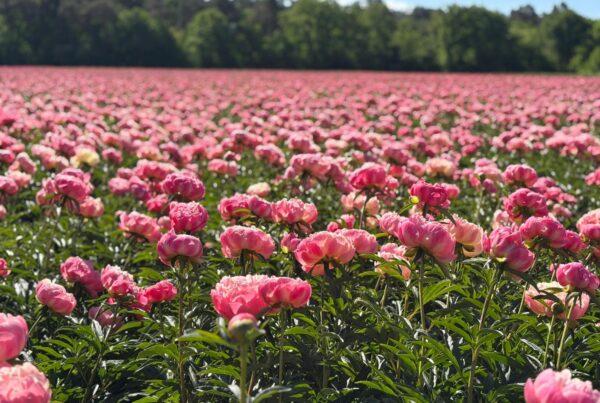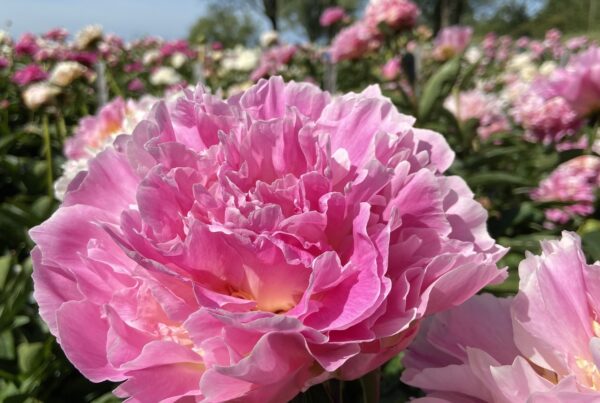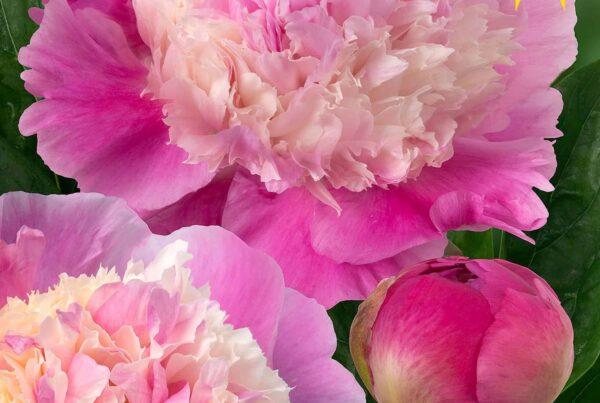In this newsletter you will find all information that is currently relevant to the crop of peonies. We trust that this information will help you in achieving a successful crop. Feel free to contact us for questions and remarks!
For a long time now you are receiving this newsletter from us. With information regarding the cultivation of peonies. Because we are always looking for ways to improve ourselves, we would like to hear from you how relevant this information actually is. What are things you would like to see differently and are there topics on which you would like to receive more information? We greatly appreciate any feedback, so please let us know!
Weeds
With peonies it is customary to spare the foliage until at least September. The continue growing of green parts means more growth. Even a crop going on dormancy ensures growth of the tuber. The fact is, the strongest growth of underground parts of the peony occurs during the withering of the foliage.
Due to the changeable Dutch summer, with very frequent rain showers, it is not easy to keep the plot weed-free. And in that case it is wise to mow the crop. Especially if it already largely has died back. Of course it makes no sense to grow a crop if it already has been overgrown by weeds.
Leaf nematodes can infect the plot by hitchhiking on weeds(seeds).
Before the winter it is therefore necessary to make sure that weeds are completely gone. But peonies are extremely sensitive for RoundUp. This herbicide, especially in combination with bluegrass, can never be used in the peony. Because the herbicide will get absorbed through the roots.
Leaf nematodes and rose buds
To limit leaf nematodes and rose buds for the coming harvest season, you can consider to cut off the foliage in early September. Leaf nematodes hibernate in, amongst other things, dead leaves on the ground and in the young growth points of the peony roots. Therefore, cut off the foliage relatively early in autumn and remove the foliage residues. Only do this with dry weather.
Botrytis control
The growing season has just passed, but preparations are already necessary to regain a good crop in the coming spring. Botrytis control, which will start in late summer, is an important part of that.
It is important to carry out Botrytis control after mowing. To kill the wounds on the plant and the spores present on the ground. These spores will eventually become winter spores and they will cause collapsing of stems in the spring. Therefore, spraying in the fall is just as important as spraying in the spring. And also remove crop residues in connection with a possible Botrytis and nematode infection.
Cutting height of foliage:
Studies have revealed that a Botrytis inhibitory effect arises if the crop is not mown too short in autumn. Thus the risk of collapsing stems in the spring is reduced. Also studies have shown that a cutting height of 7-10 cm above the ground is better for the crop than a cutting height directly above the ground.
Watering in the greenhouse or tunnel
It is important that enough water will be available for the plant in greenhouses and tunnels to take up the fertilizers. Drought in this period will damage the flower harvest for the next year. An active soil life is very important; moist soil and a correct organic matter level are very important to improve the taking in of the above mentioned fertilizers.
Yellow Fruit tree Cicada
In the greenhouse, the number of peony crops with Yellow Fruit tree Cicadas rises. Because these Cicadas emerge only after flowering, they are not harmful in small numbers. Most Cicadas can be seen in August. In September the Cicada lays eggs. Normally, control of this problem takes place in August, but please note that you probably never get rid of this plague at once.
Leatherjackets
Adult crane flies suck just a little bit of nectar. But the larvae of the crane fly, also known as leatherjackets, are much more voracious. They are relatively large, soft and fat and they eat of various plants. Including the stems of the peony just below the ground.
Way of life:
With the crane fly, six stages of development can be distinguished:
- One egg stage
- Four larval stages
- One adult stage
Adult crane flies live only for a few days. There are species which have one generation per year, but there are also species which have more generations per year. This means that the larvae are there year-round which can cause damage throughout the entire year.
Damage scenarios:
During the day, leatherjackets abide in the soil. At night they come up and eat at the stem base and lower green parts of the plant. Also, they pull the crop a little bit into the ground. Stems with a gnawed stem base wither.
Measures:
Biological control can be done with the help of parasitic nematodes Nemasys H, C or F.
Nematode sampling
Autumn is the most optimal period to determine whether an infestation with harmful nematodes occurs. Because during that period, the numbers are highest and a sample will provide the most information. Opt for a sampling including incubation, because in that case the nematodes in root remnants are also included. Discuss the result with your advisor and then take the construction plan into account; also when choosing the green fertilizer in the next growing year.
Green Works Care™
Green Works developed an effective and environmentally friendly method for the control of nematodes in peonies. In collaboration with institutes at home and abroad, we introduce Green Works Care™ for peonies. This revolutionary treatment is only available through Green Works. The research took a couple of years and the treatment has been extensively tested in that period. The result is an attractive alternative to the standard water treatment. ‘Green Works Care™ for peonies’ even has big advantages over the traditional water treatment.
The benefits of Green Works Care™ are:
- Plants do not dry out when using the Green Works Care™ treatment
- The Green Works Care™ treatment is environmentally friendly and sustainable
- Special preventive treatment against root-knot and leaf nematodes
- The plant has much more vigor in the first year
- In the second year an addition revenue of stems per plant
- No chemicals throughout the entire process
- Thus no chance of resistance to chemicals
- The treatment is safe and presents no risks to people, animals and environment
Peonies after receipt; save/store by the grower
Planting peonies is best done in the fall. In cool periods (fall) the plant roots more and that causes the plant to make more foliage in the spring. Therefore try to plant the peonies before the first frost. Peonies you plant in the fall should not be cooled during storage.
When the cooling period is too long, the plant will still sprout before winter. With the result that the crop sprouts in the winter or early spring and still suffers frost damage.
- Do not cool between September and November
- Drying out the root is disastrous for the peony
- Store the peony in the warehouse after receipt (not in the draft)
- Sufficiently cover (with moist burlap sacks) or wrap up the pallet with peonies
- Do not focus a fan or a fan from the cooling unit on the peony plant in connection with dehydration
- Before planting, dip the peonies in water for a quarter of an hour
- Planting in moist soil
- About 5 to 8 cm of planting depth with ground on top of the roots
- Irrigate the peonies after planting, allowing the ground to close around the roots
- If the structure of the soil is not good, it is better not to plant until the structure has improved
- If the peony plants cannot be planted in the fall, due to circumstances, then they must be stored after January 1st at a temperature of -2 degrees C. Packed with dry peat and in a plastic bag with ventilation holes to prevent them from drying out
- If the peony plants have to be transported in the autumn, this is best done at a temperature of 2-5 degrees C. To prevent a possible high temperature and mold
New planting
Preparation:
- Soil sample: determine main, trace elements and organic matter content. Also take a nematode sample
- Add compost if necessary
- Very good drainage of soil
- Free of root weeds
- Good soil structure
- Pre-fruit in connection with nematode infection
- Spray dead in time
- For orientation go to the auction and visit the fields where peonies are grown for the roots (purchase for a longer time)
Time of planting:
- Create a planting schedule
- Outside: September – March (the best in autumn)
- Head/eyes set upright
- In connection with structure/water balance, soil preparation is very important
- Drainage of the land
- Planting in moist soil
- Consider spraying beds/sprouting flowers
- Possibly consider placing tunnels in the future (harvest dispersion/better profit)
Planting depth:
Regarding the planting depth: +/- 5 cm ground on top of the roots. Because there are fewer flowers when planting too deep.
When planting Peonies in fall 2023; benefits of investing in 3-5 eyes compared to 2-3 eyes:
Number of stems / flowers per plant (2-3 or 3-5 eyes):
| Variety | Year | Amount of stems | Amount of stems |
| 2-3 eyes | 3-5 eyes | ||
| Sarah Bernhardt | Planting in fall: 2023 | ||
| Spring 2024 | 0 | 0 | |
| Spring 2025 | 0 | 3 | |
| Spring 2026 | 4 | 7 | |
| Spring 2027 | 6 | 8 | |
| Spring 2028 | 7 | 9 | |
| Spring 2029 | 7 | 9 | |
| Spring 2030 | 8 | 9 | |
| 32 | 45 |
In the link below you will find our extensive and updated peony assortment of 2023 – 2024:
Green Works also supplies other summer flower starting material, like: Ranunculus Butterfly™, Ranunculus Romance™, Scilla peruviana and Asclepias Beatrix®.
For more information, please consult our website or contact:
- Ed Kleijbeuker tel. 0031 (0)6 24 94 64 05 | ed@green-works.nl
- Daan Kneppers tel. 0031 (0)6 51 82 47 12 | daan@green-works.nl
Also, follow Green Works on Twitter, Facebook, Instagram and LinkedIn for more relevant information about our Peonies, amongst other things.
Green Works is the grower specialized in young planting material for Peonies, Ranunculus, special pot plants and summer cut flowers. Green Works also is a large grower of peonies for the successful cultivation for cut flower and trade, in the Netherlands and abroad. We supply within the Netherlands and globally to professional growers and (export) traders. With support in cultivation, promotion and sales, Green Works offers a total package to put an unique and healthy product on the market: www.green-works.nl/en
Green Works can never be held liable for any cultural information given and only to be used as a guideline. The grower is at all times responsible for his own action and to read the label of the chemicals being used.




